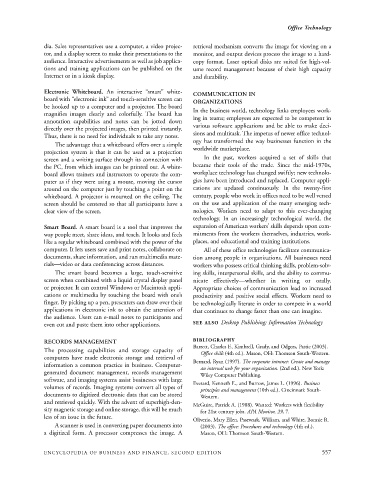Page 580 - Encyclopedia of Business and Finance
P. 580
eobf_O 7/5/06 3:17 PM Page 557
Office Technology
dia. Sales representatives use a computer, a video projec- retrieval mechanism converts the image for viewing on a
tor, and a display screen to make their presentations to the monitor, and output devices process the image to a hard-
audience. Interactive advertisements as well as job applica- copy format. Laser optical disks are suited for high-vol-
tions and training applications can be published on the ume record management because of their high capacity
Internet or in a kiosk display. and durability.
Electronic Whiteboard. An interactive “smart” white-
COMMUNICATION IN
board with “electronic ink” and touch-sensitive screen can ORGANIZATIONS
be hooked up to a computer and a projector. The board
In the business world, technology links employees work-
magnifies images clearly and colorfully. The board has
ing in teams; employees are expected to be competent in
annotation capabilities and notes can be jotted down
directly over the projected images, then printed instantly. various software applications and be able to make deci-
sions and multitask. The impetus of newer office technol-
Thus, there is no need for individuals to take any notes.
ogy has transformed the way businesses function in the
The advantage that a whiteboard offers over a simple
worldwide marketplace.
projection system is that it can be used as a projection
screen and a writing surface through its connection with In the past, workers acquired a set of skills that
the PC, from which images can be printed out. A white- became their tools of the trade. Since the mid-1970s,
board allows trainers and instructors to operate the com- workplace technology has changed swiftly; new technolo-
puter as if they were using a mouse, moving the cursor gies have been introduced and replaced. Computer appli-
around on the computer just by touching a point on the cations are updated continuously. In the twenty-first
whiteboard. A projector is mounted on the ceiling. The century, people who work in offices need to be well versed
screen should be centered so that all participants have a on the use and application of the many emerging tech-
clear view of the screen. nologies. Workers need to adapt to this ever-changing
technology. In an increasingly technological world, the
Smart Board. A smart board is a tool that improves the expansion of American workers’ skills depends upon com-
way people meet, share ideas, and teach. It looks and feels mitments from the workers themselves, industries, work-
like a regular whiteboard combined with the power of the places, and educational and training institutions.
computer. It lets users save and print notes, collaborate on All of these office technologies facilitate communica-
documents, share information, and run multimedia mate- tion among people in organizations. All businesses need
rials—video or data conferencing across distances. workers who possess critical thinking skills, problem-solv-
The smart board becomes a large, touch-sensitive ing skills, interpersonal skills, and the ability to commu-
screen when combined with a liquid crystal display panel nicate effectively—whether in writing or orally.
or projector. It can control Windows or Macintosh appli- Appropriate choices of communication lead to increased
cations or multimedia by touching the board with one’s productivity and positive social effects. Workers need to
finger. By picking up a pen, presenters can draw over their be technologically literate in order to compete in a world
applications in electronic ink to obtain the attention of that continues to change faster than one can imagine.
the audience. Users can e-mail notes to participants and
even cut and paste them into other applications. SEE ALSO Desktop Publishing; Information Technology
RECORDS MANAGEMENT BIBLIOGRAPHY
Barrett, Charles F., Kimbrell, Grady, and Odgers, Pattie (2003).
The processing capabilities and storage capacity of
Office skills (4th ed.). Mason, OH: Thomson South-Western.
computers have made electronic storage and retrieval of
Bernard, Ryan (1997). The corporate intranet: Create and manage
information a common practice in business. Computer-
an internal web for your organization. (2nd ed.). New York:
generated document management, records management Wiley Computer Publishing.
software, and imaging systems assist businesses with large
Everard, Kenneth E., and Burrow, James L. (1996). Business
volumes of records. Imaging systems convert all types of
principles and management (10th ed.). Cincinnati: South-
documents to digitized electronic data that can be stored Western.
and retrieved quickly. With the advent of superhigh-den-
McGuire, Patrick A. (1988). Wanted: Workers with flexibility
sity magnetic storage and online storage, this will be much for 21st century jobs. APA Monitor, 29, 7.
less of an issue in the future.
Oliverio, Mary Ellen, Pasewark, William, and White, Bonnie R.
A scanner is used in converting paper documents into (2003). The office: Procedures and technology (4th ed.).
a digitized form. A processor compresses the image. A Mason, OH: Thomson South-Western.
ENCYCLOPEDIA OF BUSINESS AND FINANCE, SECOND EDITION 557

